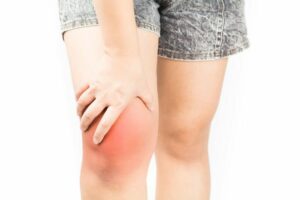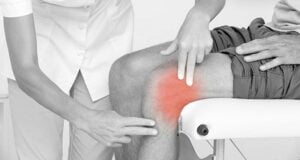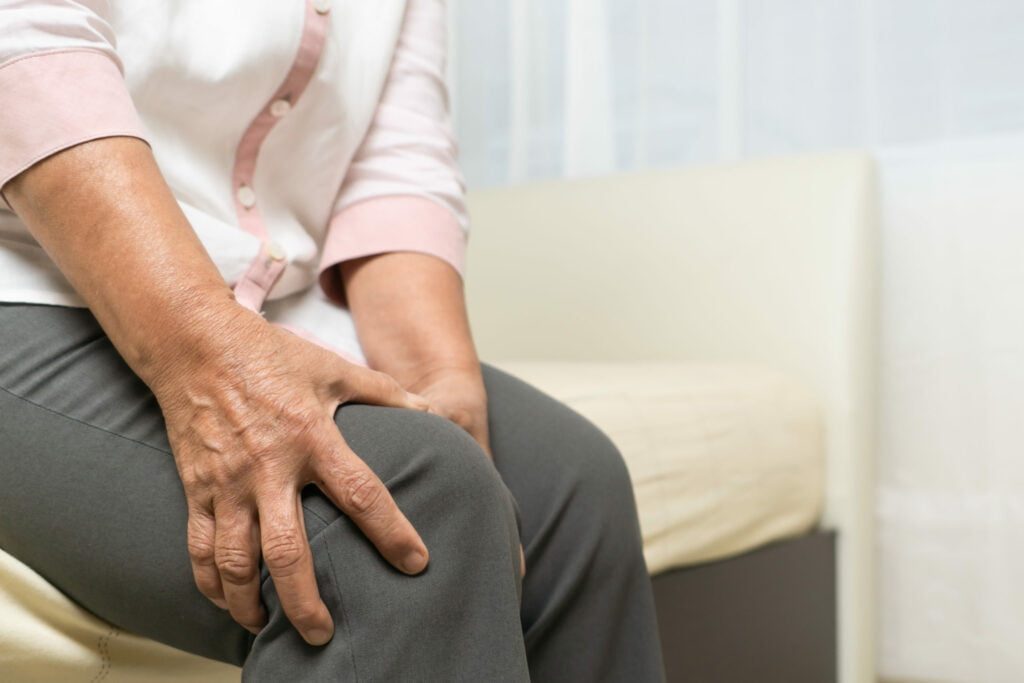A swollen knee, also known as knee swelling or knee edema, is a common condition that can affect people of all ages. It occurs when excess fluid accumulates in or around the knee joint, leading to pain, discomfort, and limited range of motion. Swollen knees can be caused by a variety of factors, ranging from injuries and overuse to underlying medical conditions. In this blog, we will delve into the causes, symptoms, diagnosis, and treatment options for a swollen knee, helping you better understand this condition and its management.
Contents
Understanding Knee Swelling
Knee swelling occurs when excess fluid accumulates in or around the knee joint, resulting in discomfort, pain, and limited mobility. It can arise suddenly due to injuries or develop gradually due to underlying medical conditions.
Common Causes of Knee Swelling

Knee swelling can be attributed to various factors, including injuries, arthritis, infections, and certain medical conditions. Some of these causes are”
- Injury or Trauma: Knee swelling is often associated with injuries such as ligament sprains, muscle strains, fractures, and dislocations. The body’s response to injury includes increased blood flow and inflammation, which can lead to fluid accumulation in the affected area.
- Arthritis: Both osteoarthritis and rheumatoid arthritis can cause knee swelling. Inflammatory processes associated with these conditions can lead to fluid buildup within the joint, contributing to pain and stiffness.
- Infections: Bacterial or viral infections can lead to knee swelling, accompanied by redness, warmth, and increased pain. Septic arthritis is a severe condition in which infection directly affects the joint, leading to inflammation and swelling.
- Bursitis: Bursae are small fluid-filled sacs that cushion the joints. When these sacs become inflamed, a condition called bursitis, fluid can accumulate around the knee, causing swelling and discomfort.
- Gout: Gout is a form of arthritis caused by the buildup of uric acid crystals in the joint. When uric acid crystals accumulate in the knee, it can lead to sudden and severe swelling, pain, and inflammation.
- Meniscus Tears: The meniscus is a cartilage structure within the knee joint. Tears in the meniscus can result from twisting motions or degeneration. Such tears can cause fluid to accumulate within the knee, leading to swelling and discomfort.
- Overuse or Repetitive Strain: Activities that involve repetitive motions or excessive stress on the knee joint can lead to inflammation and swelling.
- Other Medical Conditions: Certain medical conditions, such as systemic lupus erythematosus and other autoimmune disorders, can cause knee swelling as part of their symptom profile.
Symptoms of Knee Swelling
Knee swelling can be accompanied by a variety of symptoms that may vary depending on the underlying cause of the swelling. Common symptoms associated with knee swelling include:
- Visible Swelling: The knee may appear larger than usual due to the accumulation of fluid in and around the joint.
- Pain: Swelling in the knee can cause pain, ranging from mild discomfort to sharp, intense pain. The pain may be constant or worsen with movement.
- Stiffness: Swelling can lead to stiffness in the knee joint, making it difficult to fully extend or bend the knee.
- Limited Range of Motion: Due to the swelling and stiffness, the knee’s range of motion may be reduced, making activities like walking, climbing stairs, or bending the knee challenging.
- Redness and Warmth: Inflammation associated with knee swelling can cause the skin over the affected area to become red, warm to the touch, and tender.
- Difficulty Bearing Weight: Swelling and pain may make it uncomfortable or difficult to put weight on the affected leg or stand on the swollen knee.
- Crepitus: Some individuals may experience a crackling or grinding sensation within the knee joint when moving it.
- Instability: In cases of severe swelling, the knee joint may feel unstable or wobbly due to the disruption of the normal joint mechanics.
- Clicking or Popping: Some people with knee swelling might notice clicking, popping, or other unusual sounds when they move the knee.
- Associated Symptoms: Depending on the underlying cause of the knee swelling, additional symptoms may be present. For example, if the swelling is due to an infection, fever and chills may also occur.
Diagnosing Knee Swelling
Diagnosing the underlying cause of knee swelling involves a comprehensive approach:
Physical examination and medical history: Medical professionals assess the knee’s appearance, palpate for tenderness, and inquire about the onset and duration of symptoms.
Imaging tests: X-rays provide insights into bone and joint health, while MRI and ultrasound offer detailed images of soft tissues and fluid accumulation.
Aspiration and lab tests: Fluid aspiration involves extracting a sample of joint fluid for laboratory analysis to determine the cause of swelling, whether due to infection, inflammation, or crystals.
Treatment Options

The treatment for knee swelling depends on the underlying cause of the swelling. Here are some common treatment options that healthcare professionals may recommend:
- Rest: Resting the affected knee can help reduce inflammation and give the joint a chance to heal. Avoiding activities that exacerbate the swelling can aid in the recovery process.
- Elevation: Elevating the leg with the swollen knee can help reduce fluid accumulation by promoting drainage and reducing blood flow to the area. Elevate the leg above the level of the heart whenever possible.
- Ice Compress: Applying cold compresses or ice packs to the swollen knee can help reduce inflammation and provide pain relief. Be sure to use a cloth or towel to protect the skin and avoid applying ice directly to the skin.
- Compression: Using a compression bandage or knee brace can help reduce swelling by providing support to the joint and preventing excess fluid buildup. Make sure the compression is not too tight to avoid restricting blood flow.
- Pain Relievers: Over-the-counter nonsteroidal anti-inflammatory drugs (NSAIDs) like ibuprofen or naproxen can help reduce pain and inflammation associated with knee swelling. Consult a healthcare professional before using these medications, especially if you have any underlying health conditions or are taking other medications.
- Physical Therapy: A physical therapist can provide exercises and stretches to improve knee strength, flexibility, and range of motion. Physical therapy can also help address any muscle imbalances contributing to the swelling.
- Injections: Corticosteroid injections can be administered directly into the knee joint to reduce inflammation and provide relief from swelling and pain. Hyaluronic acid injections may also be considered for individuals with knee osteoarthritis.
- Anti-Inflammatory Medications: If the swelling is caused by an inflammatory condition such as arthritis, your doctor might prescribe stronger anti-inflammatory medications to manage the underlying inflammation.
- Surgery: In cases where the underlying cause of knee swelling is more severe, such as a torn ligament or significant joint damage, surgery may be necessary to repair the issue and alleviate the swelling.
Preventing Knee Swelling
While it’s not always possible to prevent all instances of knee swelling, there are several measures you can take to reduce the risk and minimize the likelihood of experiencing knee swelling:
- Maintain a Healthy Weight: Excess body weight can put extra stress on the knee joints, increasing the risk of inflammation and swelling. Maintaining a healthy weight through proper diet and regular exercise can help protect your knees.
- Warm Up and Stretch: Before engaging in physical activities or exercises, make sure to warm up and perform proper stretches to prepare your muscles and joints for movement.
- Use Proper Footwear: Wearing supportive and well-fitting shoes can help reduce the impact on your knees while walking, running, or participating in sports activities.
- Avoid Overuse: Avoid overexerting your knees with repetitive activities or intense exercise without proper rest. Listen to your body and give your knees time to recover.
- Strengthen Muscles: Engage in strength training exercises that target the muscles around the knees, such as the quadriceps and hamstrings. Strong muscles provide better support to the knee joint.
- Practice Good Posture: Maintaining good posture can help distribute your body weight evenly and reduce strain on your knees.
- Use Proper Techniques: When participating in sports or physical activities, use proper techniques to minimize the risk of injury. This is especially important for activities that involve jumping, twisting, or sudden changes in direction.
- Stay Hydrated: Proper hydration is important for joint health. Drinking enough water helps maintain the lubrication of your joints and can contribute to reducing the risk of inflammation.
Home Care for Knee Swelling

Here are some home care tips for managing mild knee swelling:
- Gentle Movement: Perform gentle range-of-motion exercises to prevent stiffness. Avoid activities that cause pain or discomfort.
- Avoid Heat: While ice can be beneficial for reducing inflammation, heat can potentially worsen swelling. Avoid using heating pads on the swollen knee.
- Avoid High-Impact Activities: Refrain from activities that involve jumping, running, or sudden movements that could strain the affected knee.
- Assistive Devices: If necessary, use crutches or a cane to reduce weight-bearing on the swollen knee while walking.
- Comfortable Footwear: Wear comfortable and supportive shoes to avoid placing additional stress on your knee joints.
- Limit Salt Intake: Excessive salt intake can contribute to fluid retention, so consider reducing your sodium consumption.
- Monitor for Improvement: Keep an eye on your symptoms. If they worsen or don’t improve over time, consult a healthcare provider for further evaluation.
Conclusion
Knee swelling can be caused by a range of factors, from injuries to medical conditions. Timely diagnosis, appropriate treatment, and lifestyle changes are key to managing the condition and alleviating discomfort. By understanding the underlying causes and embracing effective strategies, individuals can regain mobility and enjoy an improved quality of life.
If you’re experiencing Knee pain, physical therapy for knee pain at PhysioMantra can help: Book an online physical therapy session.



